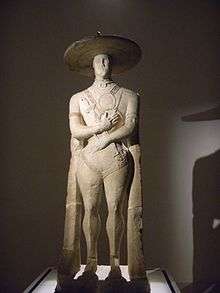Warrior of Capestrano

The Warrior of Capestrano is a tall limestone statue of a Picene warrior, dated to around the 6th century BC. The statue stands at around 2.09 m. It was discovered accidentally in 1934 by a labourer ploughing the field in the Italian town of Capestrano, along with a female statue in civilian attire, called Lady of Capestrano.[1]
Description
The Warrior statue has traces of pink paint, and features a warrior wearing a hat with a huge brim, and a disk-type armor (kardiophylax) protecting his chest and back,[1] a wide belt, necklace, and armlets. Additionally, the warrior bears a short sword, knife, axe, and a defensive device known to the Greeks as mitra (a short apron covering the back).
A South Picene inscription incised on the pillar standing to the right of the warrior reads: "Makupri koram opsút aninis rakinevíi pomp[úne]í" ("Aninis had this statue made most excellently for Rakinewis, the Pomp[onian]").
Investigation subsequent to the statue's discovery revealed that the vineyard where the statue was found was situated above an Iron Age cemetery.
References
- 1 2 Joe Basile (1993). "The Capestrano Warrior and Related Monuments of the Seventh to Fifth Centuries B.C." Revue des archéologues et historiens d’art de Louvain. Academia.edu. Retrieved 30 August 2014.
See also
| Wikimedia Commons has media related to Warrior of Capestrano. |